Ready or not, we should expect a week dominated by an even greater focus on Fed policy. There are four reasons:
- The economic data calendar is very light;
- Earnings season has ended;
- Many will be heading for the exits early, anticipating a holiday weekend; and finally
- Bernanke testifies on the economy before the Congressional Joint Economic Committee. There will also be other Fed speeches and the minutes of the last FOMC meeting.
What should we expect?
Fedspeak is described by former Fed Vice-Chair Alan Blinder as "a turgid dialect of English." In the Greenspan era, the Fed Chair was intentionally ambiguous. (Blinder, who favored a more open exchange, did not last long in the Greenspan era). In the Bernanke era there is supposed to be more transparency. There certainly is more open disagreement among the FOMC participants.
Two Viewpoints
Among market participants there is widespread sentiment that current asset prices of all types, and especially stocks, are the result of worldwide QE. These observers are ready to head for the exit at the first sign of any change in Fed policy. This perspective has been the most popular approach for several years – right or wrong.
Some others regard stock prices as pretty normal, especially since a U.S. recession seems to have been avoided. It is the reduction of fear that supports the rally. The Fed has been relevant in reducing recession chances, but the market rally reflects improvement in fundamental factors – reduced risk and stronger earnings. Most readers would be startled to learn how much negative sentiment is still reflected in current stock prices. Ed Yardeni looks at forward earnings in much the same way I do. Here is a chart showing a normal mean reversion in multiples. If you adjusted for inflation and/or the potential for other investments, we would be talking a market valuation at least 30% higher.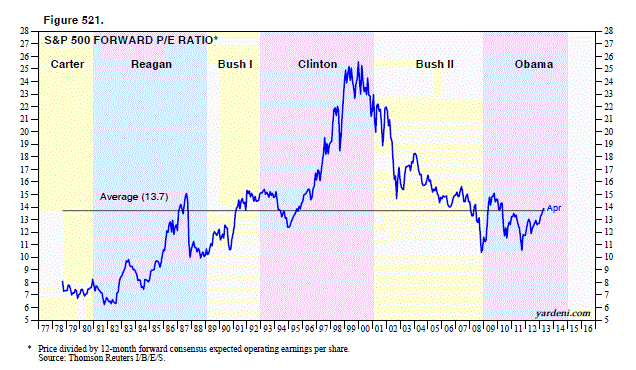
My fearless forecast is that none of the news on Wednesday – either from Bernanke's testimony or the FOMC minutes – will resolve this debate! It will provide something for the parade of pundits to talk about.
I have some thoughts on what to expect from the Fed which I'll report in the conclusion. First, let us do our regular update of last week's news and data.
Background on "Weighing the Week Ahead"
There are many good lists of upcoming events. One source I regularly follow is the weekly calendar from Investing.com. For best results you need to select the date range from the calendar displayed on the site. You will be rewarded with a comprehensive list of data and events from all over the world. It takes a little practice, but it is worth it.
In contrast, I highlight a smaller group of events. My theme is an expert guess about what we will be watching on TV and reading in the mainstream media. It is a focus on what I think is important for my trading and client portfolios.
This is unlike my other articles, where I develop a focused, logical argument with supporting data on a single theme. Here I am simply sharing my conclusions. Sometimes these are topics that I have already written about, and others are on my agenda. I am putting the news in context.
Readers often disagree with my conclusions. Do not be bashful. Join in and comment about what we should expect in the days ahead. This weekly piece emphasizes my opinions about what is really important and how to put the news in context. I have had great success with my approach, but feel free to disagree. That is what makes a market!
Last Week's Data
Each week I break down events into good and bad. Often there is "ugly" and on rare occasion something really good. My working definition of "good" has two components:
- The news is market-friendly. Our personal policy preferences are not relevant for this test. And especially -- no politics.
- It is better than expectations.
This was another good week for the stock market, but there was only mild support from the data.
- Retail sales were strongly positive. Last week I wrote that we would be focusing on the consumer, and this was a surprise for me. Steven Hansen has a very nice analysis at Global Economic Intersection. This analysis has charts and many comparisons, avoiding the controversies of the various adjustment processes. Take a look!
- Energy exporting from the U.S. is promising. See the first-rate discussion at ft.com.
- Building permits showed strong growth. Regular readers know that I favor this as a leading indicator on housing. So does Scott Grannis.
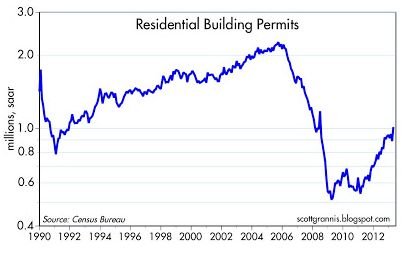
Michigan sentiment
was amazingly strong. This is very good news about consumption and employment. Here is the helpful chart from Calculated Risk. You can see the improvement to a crucial level. Check out the full article for further analysis. 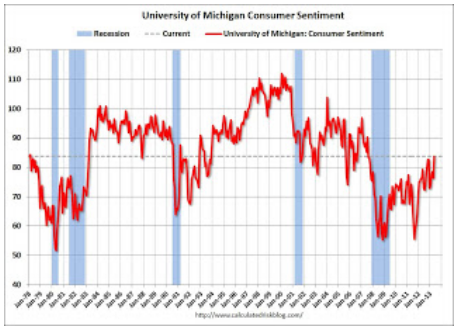
The Bad
There was plenty of bad news.
- Gas prices are moving higher. This is a surprise, since the trend in both oil and gasoline had been lower. Automotive Fleet covers this news – up six cents last week. Illinois is near the top of the list in prices ($4.20 – 4.25 here in the Chicago burbs) partly because of refinery problems. In my annual pickup trick for my son, there was a 65-cent swing in prices if you drove an hour south. (Derek has been an occasional contributor on my blog. Please indulge me in a bit of fatherly pride at his 4.0 as he completed his Junior year at Illinois).
- Household debt is lower – by 11.4% from the 2008 peak. Put another way, the U.S. consumer is reducing debt at the same time that overall consumption has been solid. See the details from Jeffry Bartash at MarketWatch.

- Initial jobless claims spiked to 360K, about 30K higher than expectations. This is a noisy series with challenges related to seasonal adjustments, so everyone watches the four-week MA. It is still bad news, and worth special attention in the next few weeks.
- Housing starts declined sharply. Calculated Risk has this story and also a more comprehensive interpretation. The housing starts are quite disappointing, but distorted a bit by the sharp decline in multi-family units. Here is a good chart showing both types:
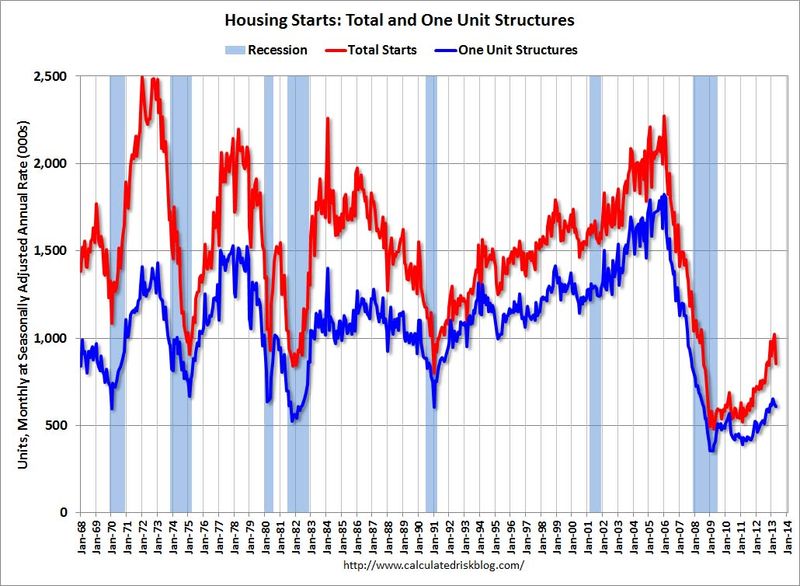
The Neutral
Sometimes it seems like we are running in place. I always read and enjoy the high frequency indicators from The Bonddad Blog. New Deal Democrat's weekly post covers many indicators beyond those highlighted here. At the moment, his conclusion is similar to my overall picture – a period of sluggish growth.
The Ugly
The IRS is the clear winner of this week's "ugly" award. The actions of this agency managed something previously thought to be impossible – unifying Congress! If you watched or read the testimony of IRS officials – can't remember, not sure about notes, etc. – do not try that at home! IRS auditors are not likely to be very forgiving when records are missing.
If this turns out to have some reach into the upper levels of the Obama Administration, it could have some market effects.
Man Bites Dog
S&P has downgraded Berkshire Hathaway (BRK.A). I had to recheck the headline! The guys who were so wrong about subprime? Who downgraded US debt after the debt ceiling debate, even though an agreement was reached – just because they did not like it? No one elected these people to dictate the public policy agenda for us. There is a very nice Reuters story on this topic, which I recommend.
The Indicator Snapshot
It is important to keep the current news in perspective. My weekly snapshot includes the most important summary indicators:
- The St. Louis Financial Stress Index.
- The key measures from our "Felix" ETF model.
- An updated analysis of recession probability.
The SLFSI reports with a one-week lag. This means that the reported values do not include last week's market action. The SLFSI has moved a lot lower, and is now out of the trigger range of my pre-determined risk alarm. This is an excellent tool for managing risk objectively, and it has suggested the need for more caution. Before implementing this indicator our team did extensive research, discovering a "warning range" that deserves respect. We identified a reading of 1.1 or higher as a place to consider reducing positions.
The SLFSI is not a market-timing tool, since it does not attempt to predict how people will interpret events. It uses data, mostly from credit markets, to reach an objective risk assessment. The biggest profits come from going all-in when risk is high on this indicator, but so do the biggest losses.
The C-Score is a weekly interpretation of the best recession indicator I found, Bob Dieli's "aggregate spread." I have now added a series of videos, where Dr. Dieli explains the rationale for his indicator and how it applied in each recession since the 50's. I have organized this so that you can pick a particular recession and see the discussion for that case. Those who are skeptics about the method should start by reviewing the video for that recession. Anyone who spends some time with this will learn a great deal about the history of recessions from a veteran observer.
I have promised another installment on how I use Bob's information to improve investing. I hope to have that soon. Anyone watching the videos will quickly learn that the aggregate spread (and the C Score) provides an early warning. Bob also has a collection of coincident indicators and is always questioning his own methods.
I also feature RecessionAlert, which combines a variety of different methods, including the ECRI, in developing a Super Index. They offer a free sample report. Anyone following them over the last year would have had useful and profitable guidance on the economy.
RecessionAlert has developed a comprehensive package of economic forecasting and market indicators, well worth your consideration.
Unfortunately, and despite the inaccuracy of their forecast, the mainstream media features the ECRI. Doug Short has excellent continuing coverage of the ECRI recession prediction, now well over a year old. Doug updates all of the official indicators used by the NBER and also has a helpful list of articles about recession forecasting. His latest comment points out that the public data series has not been helpful or consistent with the announced ECRI posture. Doug also continues to refresh the best chart update of the major indicators used by the NBER in recession dating. It is time for a fresh look at his "Big Four" chart. 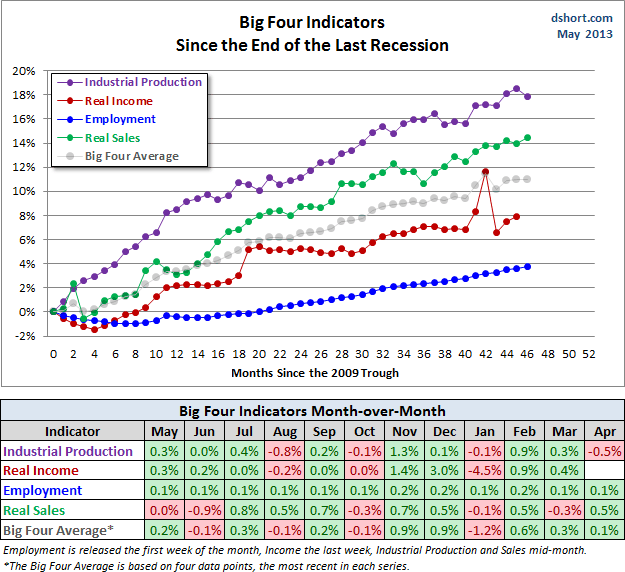
Doug reviews the latest (umpteenth) change in the ECRI methods, showing why there is nothing magical about nominal year-over-year growth in GDP of 3.7%. Short answer: low inflation distorts the analysis.
The average investor has lost track of this long ago, and that is unfortunate. The original ECRI claim and the supporting public data was expensive for many. The reason that I track this weekly is that it is important for corporate earnings and for stock prices. It has been worth the effort for me, and for anyone reading each week.
Readers might also want to review my Recession Resource Page, which explains many of the concepts people get wrong. 
Our "Felix" model is the basis for our "official" vote in the weekly Ticker Sense Blogger Sentiment Poll. We have a long public record for these positions. After a brief move to "neutral" about a month ago we switched back to a bullish position. These are one-month forecasts for the poll, but Felix has a three-week horizon. Felix's ratings stabilized at a low level and improved significantly over the last few weeks. The penalty box percentage measures our confidence in the forecast. A high rating means that most ETFs are in the penalty box, so we have less confidence in the overall ratings. That measure has moved lower, so we now have more confidence in short-term trading.
[For more on the penalty box see this article. For more on the system ratings, you can write to etf at newarc dot com for our free report package or to be added to the (free) weekly ETF email list. You can also write personally to me with questions or comments, and I'll do my best to answer.]
The Week Ahead
This week brings little in the way of economic data.
The "A List" includes the following:
- Initial jobless claims (Th). This is the high-frequency indicator on employment. Interest will be especially high after last week's surprise spike.
- New home sales (Th). Interest is greater than usual. Many are counting on strong housing data to offset the sequester, and expectations are high for the spring.
- Existing home sales (W). See above.
The "B List" includes the following:
- Durable goods (F). Interesting but volatile series.
- FOMC minutes (W). From the May 1stmeeting.
- FAFA home prices (W). These are the prices from the regular homes in the government market.
Various Fed speeches, highlighted by Bernanke's testimony on Wednesday morning, just after the market open.
Trading Time Frame
Felix has continued a bullish posture. Even with a brief move to a "neutral" overall rating, Felix continued to find at least three attractive sectors. The positions were pretty defensive until about ten days ago. Felix has picked up the shift to cyclical stocks and technology, and also the move to financials. The trading picture is attractive and broadly-based.
Investor Time Frame
Each week I think about the market from the perspective of different participants. The right move often depends upon your time frame and risk tolerance.
What NOT to do
Let us start with the most dangerous investments, especially those traditionally regarded as safe. Interest rates have been falling for so long that investors in fixed income are accustomed to collecting both yield and capital appreciation. An increase in interest rates will prove very costly for these investments. I highly recommend the excellent analysis by Kurt Shrout at LearnBonds. It is a careful, quantitative discussion of the factors behind the current low interest rates and what can happen when rates normalize.
Other yield-based investments have a similar or greater risk profile. As David Kehohane of FTAlphaville notes, even junk bonds are now yielding less than 5%!
Find a safer source of yield: Take what the market is giving you!
For the conservative investor, you can buy stocks with a reasonable yield, attractive valuation, and a strong balance sheet. You can then sell near-term calls against your position and target returns close to 10%. The risk is far lower than for a general stock portfolio. This strategy has worked for over two years and continues to do so.
Balance risk and reward
There is always risk. Investors often see a distorted balance of upside and downside, focusing too much on new events and not enough on earnings and value.
Three years ago, in the midst of a 10% correction and plenty of Dow 5000 predictions, I challenged readers to think about Dow 20K. I knew that it would take time, but investors waiting for a perfect world would miss the whole rally. In my next installment on this theme I will deal with the logic behind the prediction. It is important to realize that there is plenty of upside left in the rally, as Barron's notes this week in the cover story, We Were Right!
Get Started
Too many long-term investors try to go all-in or all-out, thinking they can time the market. There is no reason for these extremes. There are many attractive stocks right now – great names in sectors that have lagged the market recovery. You can imitate what I do with new clients, taking a partial position right away and then looking for opportunities.
We have collected some of our recent recommendations in a new investor resource page -- a starting point for the long-term investor. (Comments and suggestions welcome. I am trying to be helpful and I love feedback).
Final Thought
What should we expect from this week's Fed news?
I expect Bernanke to re-emphasize the commitment to economic growth. The markets have clearly not gotten the message. The Fed is determined to avoid deflation. There is little inflation risk, especially using the Fed's preferred measure, the PCE index. The public consensus is that stimulus will be gradually withdrawn as the economy improves. Why not accept that message? Those who have taken the Fed at its word have done much better than the perpetual skeptics.
Here is another perspective from Jim O'Neill, economist and former Chairman of Goldman Sachs Asset Management. I especially like sources who are not selling a particular product, and so should you.
"Our stock markets seem to be enjoying themselves. Many ascribe the robust performance of stocks as nothing more than the consequence of friendly monetary policies all over the world. While I am sure this is playing its part, it was just as fashionable to argue the same easy monetary policies were also fuelling the commodity rally some time ago, so perhaps it isn't that simple.
Maybe something a bit more substantive is happening. After the pleasant surprise of +0.3pc real GDP in the UK in Q1, many of us were braced for the resulting setback, which would follow the pattern of the past couple of years. But while it is early days, quite a bit of recent economic news has continued to be on the positive side.
While much of the eurozone continues to struggle, US performance remains encouraging; a housing recovery and a competitive boost from cheaper domestic energy seem to have underpinned the improvement.
And, while we don't export a great deal to Japan these days, the improving mood of the Japanese consumer to the country's monetary and fiscal boost suggests that a number of other economies will take heart. It is too soon to be singing in the streets, but the signs are looking better than they have for a while."
This really nails it. Those who have been completely wrong about the economy and the stock market have blamed Fed policy for every move in every market.
Do you remember when the price of tacos was blamed on Bernanke?
I started to explain this with my controversial article on the flaw in David Tepper's analysis. I accept Tepper's conclusion, but I object to those who take shortcuts in economic analysis. I'll have more on this theme.
Investment Implication
I understand that most of the world is programmed for a knee-jerk response to any news about the Fed. Eventually, the actual effects – both on the economy and corporate earnings – will prove to be more important. Some think that they can anticipate and "game" the reactions of others. That might be worth trying. But shouldn't we start with a better understanding of reality?
If you get the fundamentals right, you will be a successful investor.
